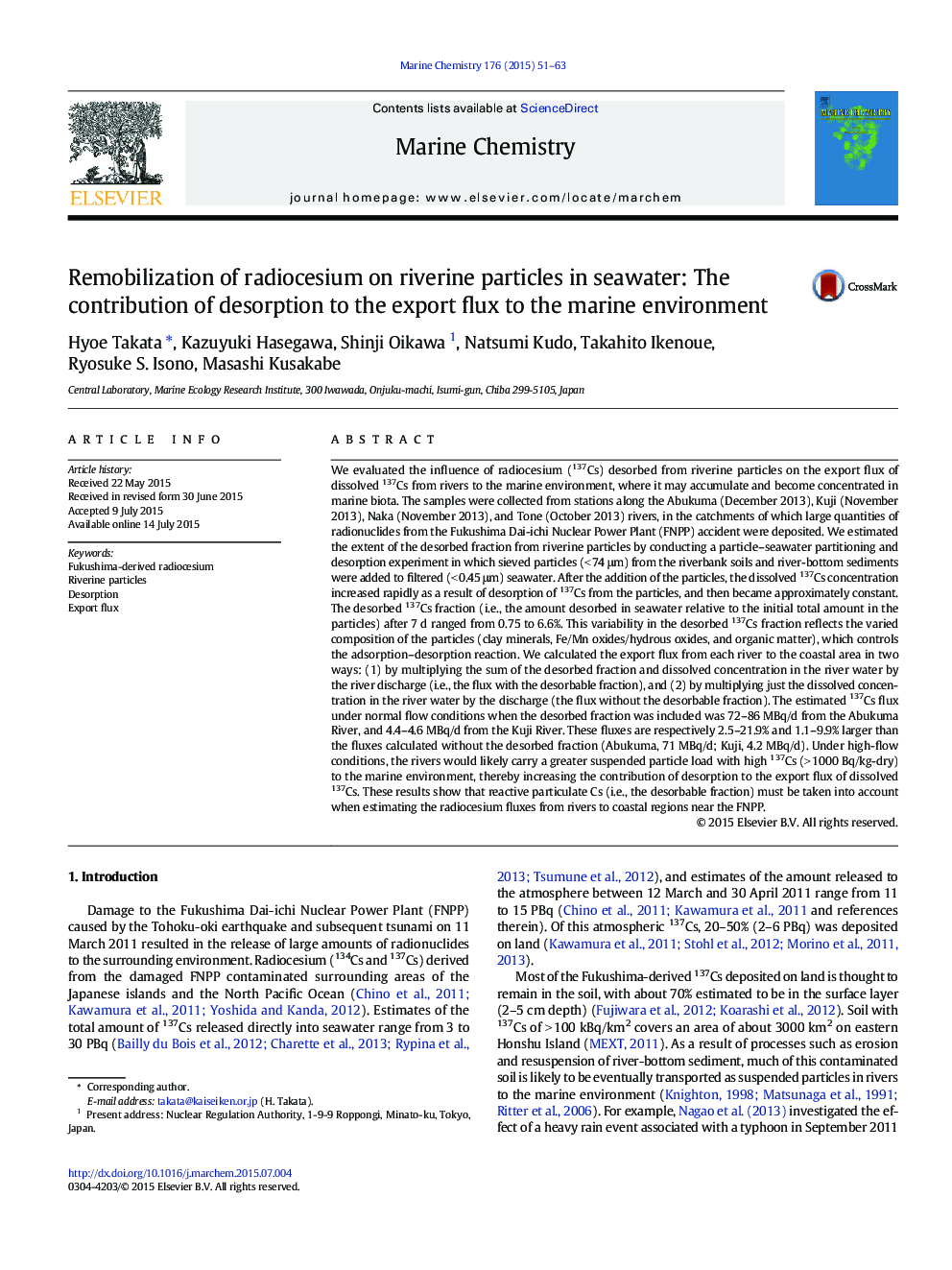| کد مقاله | کد نشریه | سال انتشار | مقاله انگلیسی | نسخه تمام متن |
|---|---|---|---|---|
| 7699220 | 1496659 | 2015 | 13 صفحه PDF | دانلود رایگان |
عنوان انگلیسی مقاله ISI
Remobilization of radiocesium on riverine particles in seawater: The contribution of desorption to the export flux to the marine environment
ترجمه فارسی عنوان
مجددا استفاده از رادیوسیم در ذرات رودخانه در آب دریا: سهم جذب در شار صادرات به محیط دریایی
دانلود مقاله + سفارش ترجمه
دانلود مقاله ISI انگلیسی
رایگان برای ایرانیان
کلمات کلیدی
موضوعات مرتبط
مهندسی و علوم پایه
شیمی
شیمی (عمومی)
چکیده انگلیسی
We evaluated the influence of radiocesium (137Cs) desorbed from riverine particles on the export flux of dissolved 137Cs from rivers to the marine environment, where it may accumulate and become concentrated in marine biota. The samples were collected from stations along the Abukuma (December 2013), Kuji (November 2013), Naka (November 2013), and Tone (October 2013) rivers, in the catchments of which large quantities of radionuclides from the Fukushima Dai-ichi Nuclear Power Plant (FNPP) accident were deposited. We estimated the extent of the desorbed fraction from riverine particles by conducting a particle-seawater partitioning and desorption experiment in which sieved particles (< 74 μm) from the riverbank soils and river-bottom sediments were added to filtered (< 0.45 μm) seawater. After the addition of the particles, the dissolved 137Cs concentration increased rapidly as a result of desorption of 137Cs from the particles, and then became approximately constant. The desorbed 137Cs fraction (i.e., the amount desorbed in seawater relative to the initial total amount in the particles) after 7 d ranged from 0.75 to 6.6%. This variability in the desorbed 137Cs fraction reflects the varied composition of the particles (clay minerals, Fe/Mn oxides/hydrous oxides, and organic matter), which controls the adsorption-desorption reaction. We calculated the export flux from each river to the coastal area in two ways: (1) by multiplying the sum of the desorbed fraction and dissolved concentration in the river water by the river discharge (i.e., the flux with the desorbable fraction), and (2) by multiplying just the dissolved concentration in the river water by the discharge (the flux without the desorbable fraction). The estimated 137Cs flux under normal flow conditions when the desorbed fraction was included was 72-86 MBq/d from the Abukuma River, and 4.4-4.6 MBq/d from the Kuji River. These fluxes are respectively 2.5-21.9% and 1.1-9.9% larger than the fluxes calculated without the desorbed fraction (Abukuma, 71 MBq/d; Kuji, 4.2 MBq/d). Under high-flow conditions, the rivers would likely carry a greater suspended particle load with high 137Cs (> 1000 Bq/kg-dry) to the marine environment, thereby increasing the contribution of desorption to the export flux of dissolved 137Cs. These results show that reactive particulate Cs (i.e., the desorbable fraction) must be taken into account when estimating the radiocesium fluxes from rivers to coastal regions near the FNPP.
ناشر
Database: Elsevier - ScienceDirect (ساینس دایرکت)
Journal: Marine Chemistry - Volume 176, 20 November 2015, Pages 51-63
Journal: Marine Chemistry - Volume 176, 20 November 2015, Pages 51-63
نویسندگان
Hyoe Takata, Kazuyuki Hasegawa, Shinji Oikawa, Natsumi Kudo, Takahito Ikenoue, Ryosuke S. Isono, Masashi Kusakabe,
